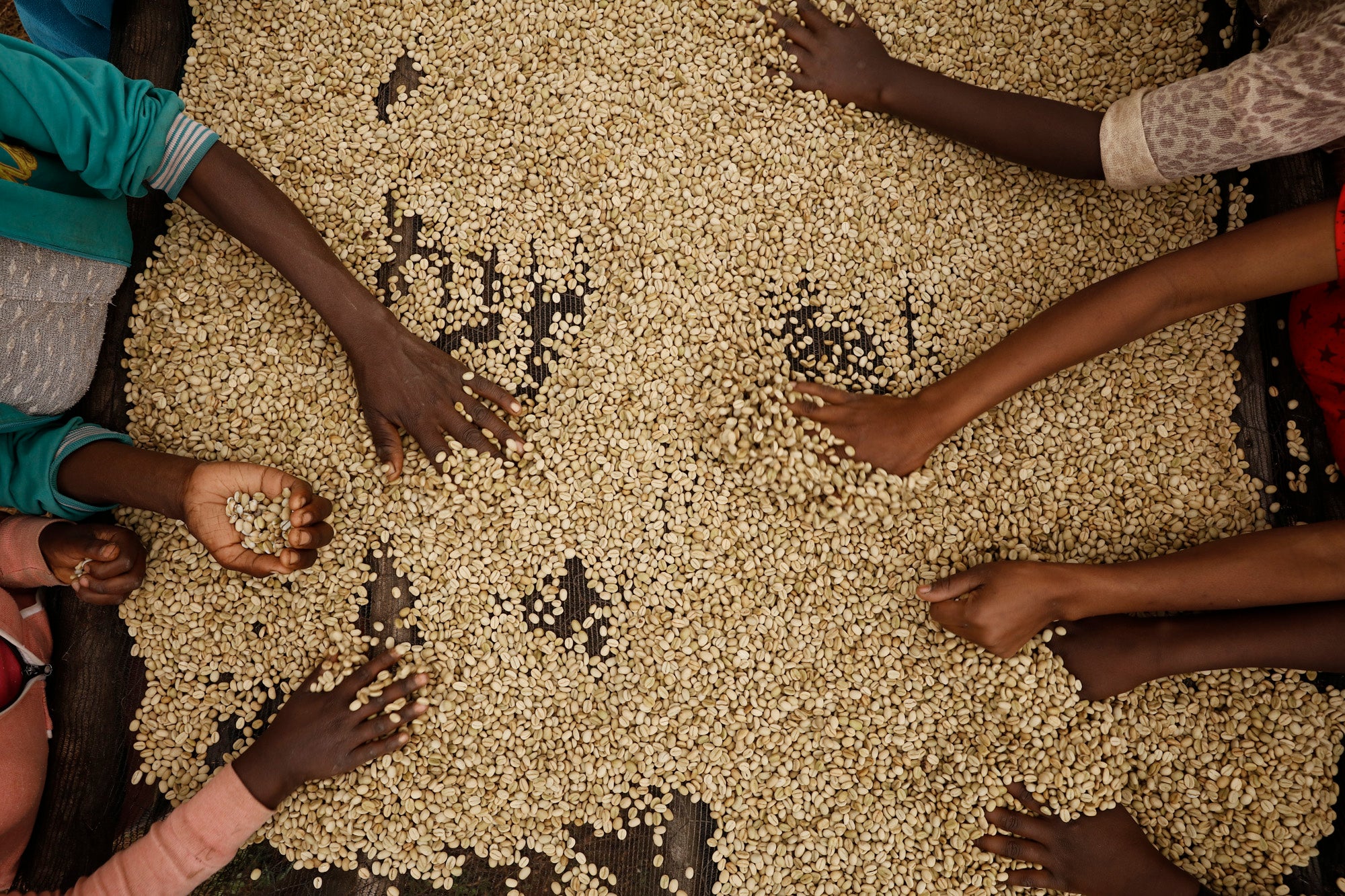San Cayetano, Yellow Honey Red Bourbon, El Salvador 2018
Vi har tagit hem kaffe från San Cayetano i El Salvador som har bearbetats på tre olika sätt. Processerna Gul honung, tvättad och naturlig kommer var och en att belysa olika aspekter av kaffet.
Detta är den gula honungsversionen av kaffet, vilket innebär att fruktköttet från körsbäret har tagits bort, men slemmet har stannat kvar under torkning av bönorna. Slemmet är väldigt klibbigt och honungsliknande, därav namnet. Den "gula" indikerar bara hur mycket slem som finns kvar, röd honung är mest och gul näst minst. Den bearbetade honungen ger en krämighet till kaffet, du hittar även toner av marsipan, rött äpple och clementinsyrlighet i eftersmaken.
Om Rafael och Carmen Silva Hoff
Detta kaffe kommer från Rafael och Carmen Silva Hoff som är baserade i Ahuachapán i Santa Ana. Paret har en bearbetningsstation, Sicafe, där de bearbetar kaffe till omgivande bönder. Carmen sköter all logistik, inte bara för våra inköp, utan även för andra bönder för vilka de förädlar kaffe. Vid bearbetningsstationen är Rafael arbetar praktiskt i flera timmar varje dag, men uppslutningen på bearbetningsstationen är också av högre standard än vi har sett på andra håll i El Salvador, t.ex. har de ett separat rum där besättningen kan sitta och äta lunch och regler om att tvätta händerna och hygien runt kaffet. Personal på plats vänder också bara kaffet för hand, logga fukten i olika skeden av torkningsprocessen och ha tillgång till ett fantastiskt koppningslabb med en välutbildad besättning i smak och rutiner.
Om San Cayetano
Detta kaffe kommer från Carmen och Rafaels gård, som heter San Cayetano. Den ligger i extremt branta och blåsiga förhållanden där löven blåser direkt från träden, vilket gör dem svagare och mindre produktiva. Granngårdarna till San Cayetano lider hårt av lövrost som lätt kan överföras till växterna i San Cayetano med vind. Av dessa skäl har avkastningen varit lägre de senaste åren. Men Rafael och Carmen har byggt fler vindjackor för att skydda sina växter och gårdens chef, Marco Roudrigues, har lagt ner mycket ansträngning och många timmar på att applicera sulfat och gödningsmedel. När vi besökte gården tidigare i år var den frodigare och hade en mycket större skörd. Förra året hade de mycket av gården som drabbades hårt av rojan och Marcos har applicerat opera och zink (hjälper löven). De använder också naturligt organiskt gödningsmedel som tillverkas på gården. San Cayetano ser riktigt frisk och frodig ut.
Om sorten Red Bourbon
De röda bourbonträden är ganska höga och har tunnare taggar. Varje år talar Rafael om att plantera Caturra istället för Red Bourbon i San Cayetano. Caturra är kortare och djärvare och skulle vara mer motståndskraftig mot vinden. Men Rafael älskar smakegenskaperna hos Red Bourbon. Generellt i El Salvador tycker jag att de olika sorterna av Bourbon smakar väldigt söta och komplexa.
Bourbonsorten upptäcktes först på Bourbonön, därav namnet, och har spridits och odlas nu över hela kaffeodlingsvärlden. Ursprunget kanske på ön Bourbon eller kanske Etiopien, har denna sort många undersorter: Gul-, Orange- och Röd Bourbon. På grund av dess generellt låga avkastning tenderar Bourbon att producera en kopp av mycket hög kvalitet (det finns bevis för att ju lägre avkastning desto högre kvalitet eftersom växten kan använda sin energi mer effektivt). Typiska koppegenskaper för Red Bourbon i El Salvador är en låg-medium kropp, balanserad, chokladaktig, låg-medium syra med en typiskt söt profil; detta är förstås en väldigt allmän beskrivning.
Om processen för gul honung
Detta är Gul honung version av kaffet, vilket innebär att fruktköttet från körsbäret har tagits bort genom att massa kaffet, men slemmet har blivit kvar under torkning istället för att tvätta bort det som i tvättprocessen. Slemmet är väldigt klibbigt och honungsliknande, därav namnet. Gult indikerar bara hur mycket slem som finns kvar på bönorna, röd honung är mest och gult minst. Kaffet har torkats direkt under solen de första dagarna och sedan i torkhuset på högbäddar, konsekvent flyttat för hand för jämn rotation och torkning. Varje dagsparti hålls åtskilda och avlägsnas i lager. Som honungsprocess torkas kaffet i totalt 16-22 dagar.
Droppa kaffe och San Cayetano
Det är fjärde året vi köper kaffet från Carmen och Rafael. Familjen är så professionell att arbeta med och är så hårt arbetande och de vänligaste människorna. De har full kontroll från gården under hela processen och exporterar till oss. De senaste åren har vi haft San Cayetano som julkaffe. Så låt oss bara säga att julen kom väldigt tidigt i år.
FAKTA
Producent: Rafael och Carmen Silva Hoff
Gård: San Cayetano
Processstation: Sicafe
Region: Ahuachapán, Santa Ana
Sort: Röd Bourbon
Valt: februari till mars 2018
Process: Gul honung
Höjd: 1550 möh
Smakbeskrivning: Ett krämigt kaffe, med toner av marsipan, rött äpple och clementinsyrlighet i eftersmaken.
